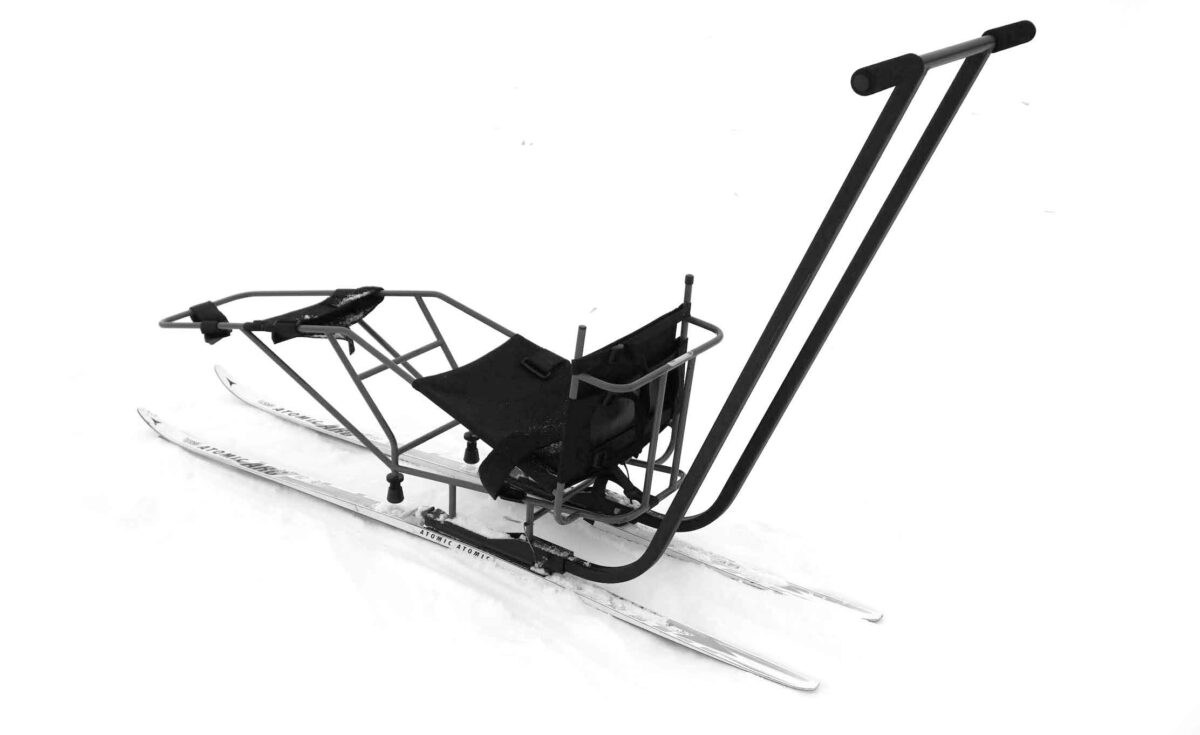Winterpeg is for Everyone: Information for getting outdoors in the winter for people with disabilities (…and anyone who wants to make the winter world more accessible too)
Below we’ve compiled some some helpful tips and tricks for getting outdoors if you are a person with a disability – and some ways anyone can help make the winter world accessible. This page also serves as guidance for our own organization (Winnipeg Trails) when planning winter events and a place to share what we’ve learned along the way. We think you’ll find some interesting info here that is hard to find elsewhere.
So, if you are a person with a disability curious about the right equipment or are simply curious about making the outdoors accessible in winter for people of all abilities, read on!
Skip to programs and general info
Skip to all equipment
Skip to Sit Ski Info
About Winter and Mobility
First of all, no one, no matter their ability, is a winter expert. There are always new things to try and every winter is different. Winter cities are special places that take on a whole new life once the snow starts to fall. Hard ground turns soft. Abrasive surfaces become slippery. The whole worlds starts to glisten and things even sound different!
Winter affects people in different ways, and how they use their body, how their mobility aids and how they use their senses to move around is affected too.
Winter sports and transport options are literally out of this world. Have you ever seen someone ride behind a reindeer? Yup, that’s a thing. Winter opens up all kinds of possibilities – and some barriers too.
Trying new things can be exhilirating. It can also be scary, especially if you are someone who faces a few barriers to being physically active at other times of year. Let’s face it, the cold hurts our face and it can get dangerous out there when mobility is an issue. It makes sense that some of us might have questions about what’s out there and how to do it.
Whether you see it as an opportunity or a challenge, “overcoming” the winter is definitely worth it.
Winnipeg Trails believes everyone should have access to their community parks and outdoor spaces regardless of the season. We hope our mobile ski library inspires you to see yourself and your loved ones and your whole community moving outside this winter!
Our programs
Choose your own adventure at our mobile ski libraries! Just getting people and equipment in the same place is half the battle. That’s why Winnipeg Trails is hosting free events all over the city. There is a wide range of equipment out there, and sometimes the equipment matters. So bringing it all in one place can really help.
One of the reasons that we move around the city is that we know geography is one aspect of accessibility. If you face challenges to move around, the closer to where you live, the better.
Remember:
- All abilities are welcome at every mobile library location
- Check out or list of adapted equipment
- Locations all over the city
- Specialized community events
- We have kids skis, sit skis and wheel blades
We also host Specialized Community Events. One important example is our weekly Adapted Ski program. To learn more please email [email protected]
We invite persons with any form of disability to try skiing, snowshoeing or kicksledding together. It is also a great chance for those who already know-how to share their enthusiasm and knowledge.
You can try specialized adapted equipment if you need, or meet a ski guide with more experience or share what skills you have accrued.
Our adapted equipment and trail guides can almost always be found at every library location. All ages and all abilities are welcome too.
We also do some very special events, such as the try-it paralympic biathlon, where participants got to try lazer target shooting from a sit ski before venturing out in the snow to try the real thing!
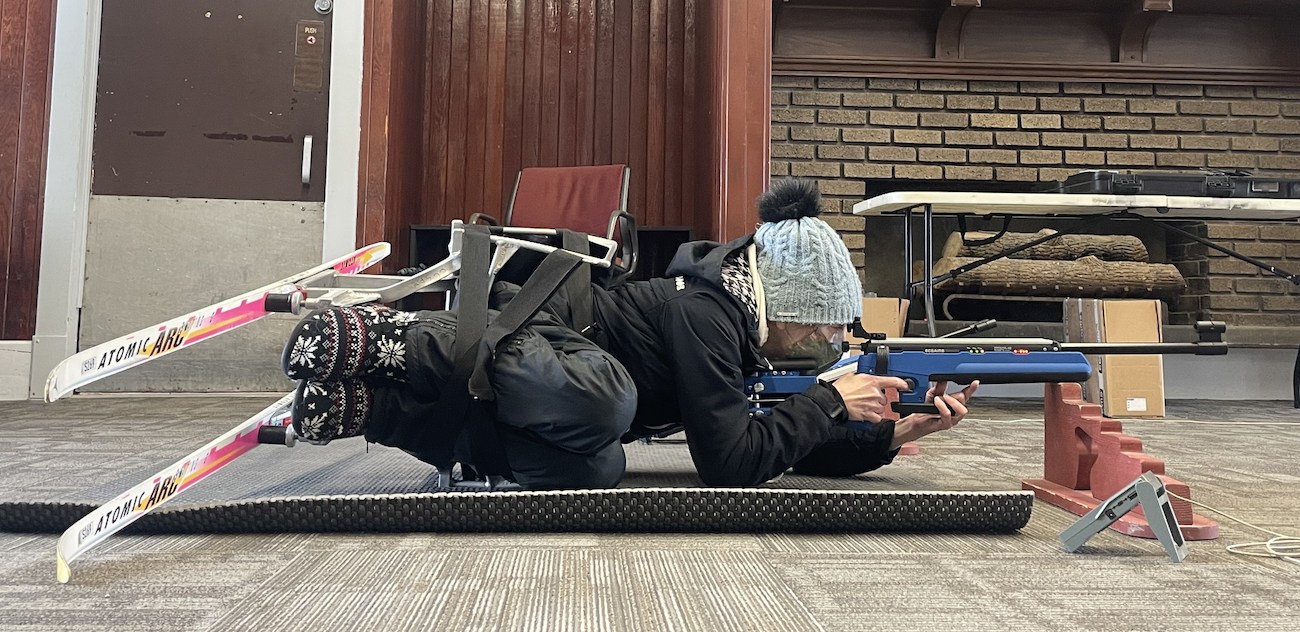
If you have questions about the programs we offer now or in future, please contact [email protected]
Outlook and Attitude
The biggest barrier to inclusion is attitudinal.
After that, a lot of thingsbecome pretty pretty straightforward. Let’s take a moment this winter to look at our community spaces, and how we can make them more accessible and inclusive to everyone.
One surefire way to make a person feel unwelcome is to ignore their basic needs, and we all do that too often. It is especially noticeable when people who don’t experience many barriers are in charge. They simply don’t know. It requires an active approach.
Here are some examples of things anyone can do to try and better understand how to eliminate barriers:
- Try adapted equipment. Have a seat in a sit ski and explore the trail. One way we can learn about accessibility is putting ourselves in the shoes (or skis) of someone who might require adaptations to be physically active.
- Volunteer to be a ski guide for a blind or vision impaired person. Based on the Ski for Light: Guide Handbook, we can all learn how to bring new friends on the trails.
- Dig it out! Snow can make the world impassable. We can’t make every street accessible ourselves, but its often the little things we can do that will be appreciated. Benches and picnic tables are great gathering places no matter the season. For our events, we try to take stock of whether people have access to all areas of a space, for example.
- Share your joy and give the gift of mobility. If you are already in love with winter, take a moment to invite a friend or family member to one of our library locations who might fall in love too. It is much less scary to try something new when there is a friend nearby and you might just gain a new adventure buddy. If you have independent transport, or have been there before, offer to take them. One of the biggest barriers to being active outdoors in the winter is the “getting there” part.
Skis for different abilities
Let’s talk about skiing.
First of all, the most important advice to any new skier: relax and give it a try!
If you are a new skier and you have a disability, the most important advice is the same: relax and give it a try!
Depending on the form of disability(ies) you have, you might not need to think much about equipment at all.
For example, while people who can’t move their legs might require a sit ski, a person with a severe visual impairment may simply want regular skis and a little extra info on the trail. But one thing is usually true: anyone trying something new will benefit from whatever equipment will be the easiest to try.
So let’s talk about ski equipment in general terms first, touching on a few things that might be relevant to a person with a disability wondering how it works.
Skiing can be intimidating mo matter who you are, so don’t let it stop anyone. People with an impairment that affects their ability to ski – whether it is a cognitive, visual or physical impairment – will usually appreciate eliminating unnecessary barriers. Make the first attempt as successful as it can be.
At the Winterpeg mobile ski libraries, we help match enthusiastic skiers with the boots, skis and poles they need – or the adapted equipment to make a skiing-like experience work. It takes time to get used to everything that is out there in the world of skis, or to learn the lingo, but it rarely matters and the principles are generally the same.
Alright. Unless you need a sit ski, or you’ve decided to kicksled instead, you’re gonna need ski boots. We’ll save you all the mundane nerdly info about the various types of bindings out there for a different article. Besides, we can help with that. All anyone needs to know is that boots need to match the bindings – but that will be obvious. If you can put on a shoe, you can put on a ski boot!
Next, you need some skis.
Truly “dialing in” ski length is determined by height, weight and experience level, but don’t worry too much about getting it perfect …especially at first.
A good tip is to choose skis that are a little shorter than, well, a pro would use. Make it easy. Do that by choosing skis that are the user’s height or a bit shorter. They won’t be as speedy, but they will be easier to manage.
New skiers of any ability might also consider getting the hang of moving without poles first (poles are just one more thing to think about and you they can be distracting). Of course, if leg strength or balance is an issue, poles can stand-in for a cane or even help with a little extra push to get moving, so its really up to the person.
For most new skiers though, its a good idea to leave the poles to the side and, once you get used to shuffling around on the skis, grab some poles and try to get the hang of it.
Anyone who is new to skiing may need some help getting in and out of bindings. Someone with cognitive impairments or hand/arm injuries may find the dexterity requires extra tough – a lot of people with full range of motion due too.
You can also do anyone new to skiing a favour and give them some tips on how to get up (roll on your back, crawl on all fours toward your ski tips, and then “lunge”).
If that all sounds way too complicated, that;’s because it is. So remember rule #1: relax and try it!
Wanna know more? Ok OK. Its a good idea to have a friend (or us) tell you about wax some time (not all skis need the kick kind – most modern ones don’t and the glide kind is something you usually do once a year). Oh and make sure someone who knows shows you how to properly use on the pole straps (always grab both the strap and the handle). We can do that for you too!
If you have limited mobility, or a balance issue for example, or are simply unable to stand up and ski, then check out our adapted equipment below or continue on reading about kicksleds!
Not just skis…
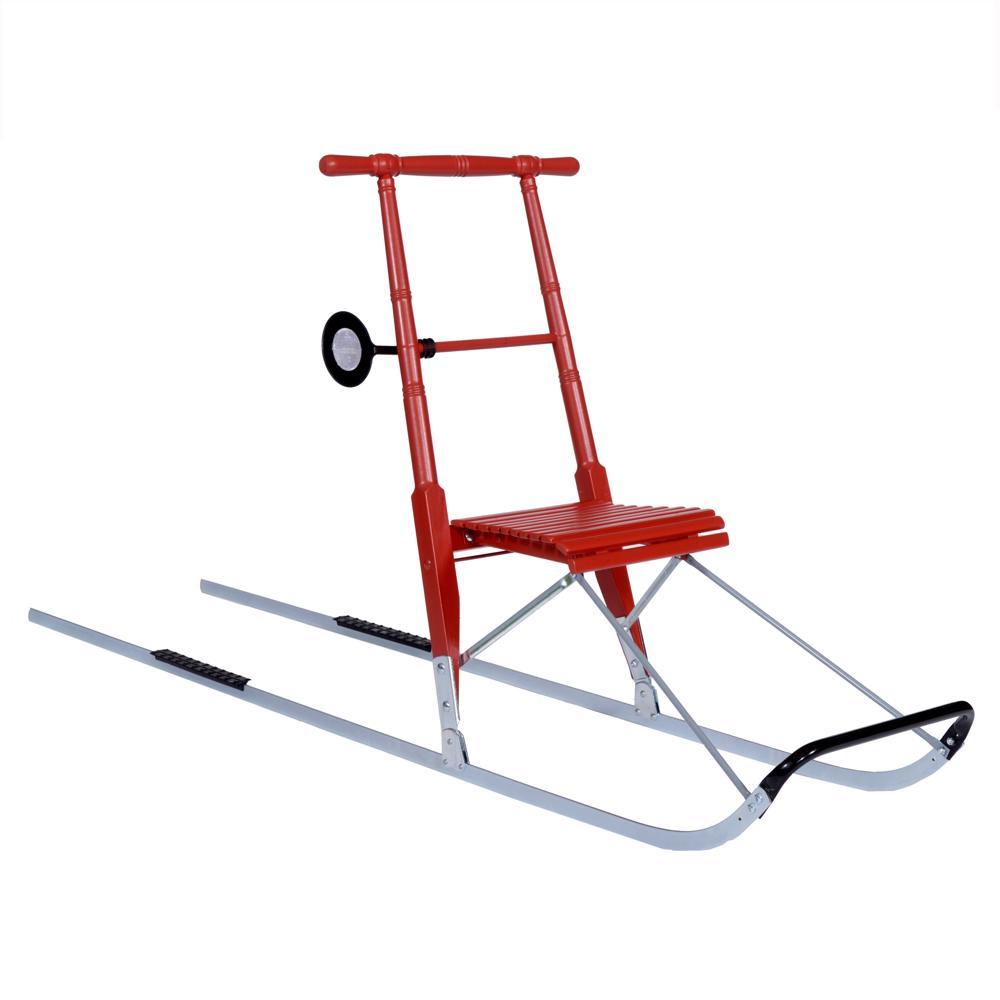
Kicksleds
Kicksledding is like skiing with benefits. It doesn’t require a track, and it comes with a place to sit! Kicksleds don’t work too well in deep snow, but all you need is a snowy sidewalk or a few inches on hard ground to give it a go.
- A kicksled consists of a small chair mounted on two long and flexible runners or skis
- The kicksled is driven forward by the driver standing on one runner, kicking backwards on the ground with the other foot (similar to a skateboard motion)
- You can use the sled to carry a passenger or luggage
- It is designed to used on hard packed snow or icy surfaces
- Kicksleds are very easy to use and suitable for people of all ages
- Kicksleds can make an accessible addition to winter activities as they provide stability and a place to sit
- Kicksleds can be great for inner ear and other balance issues, and they are not as challenging as skiing. Many people get the hang of it immediately and they are tons of fun
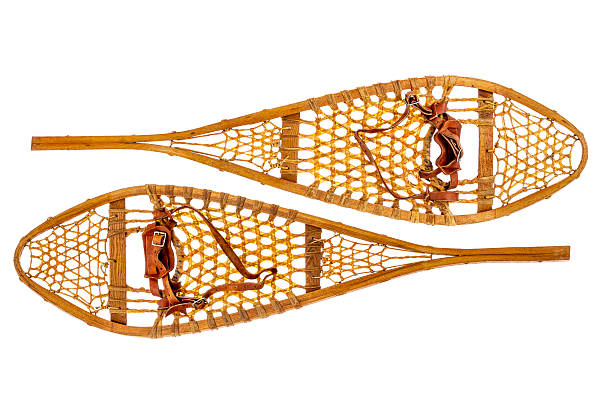
Snow shoes
- Snow shoes are designed to assist us when walking on the snow by spreading out our weight over a larger footprint
- They attach to your own boots
- Traditionally made of wood and leather, we have of those, plus some metal and synthetic material snow shoes in our library
- We have a number of different sizes and styles of snow shoes in our library, but generally speaking snowshoes will fit just about anybosy
- They are easy and fun to use….we might put you to work breaking some trails

Ahkio (sled)
- Traditionally an ahkio is a lightweight, canoe shaped sled used for transporting cargo. They can have ski runners or be flat. They are common in Finland where people use them to carry their children or camping supplies.
- Ahkios can be en excellent way for someone with a severe mobility impairment and a helper to get out and experience a ski trail
- We built our own version so that families and friends could pull each other! Its easier than you think.
- You can ski or snowshoe in font of the ahkio, while it is attached to your waist
- Ask us how you can turn a toboggan into an ahkio!
Adapted Equipment
Who uses adaptive equipment?
- Persons with a disability
- The active aging community
- Folks who are recovering from an injury
- Anyone who is interested in trying adapted equipment
Each of our sit skis offer different levels of support and require different physical skills, you are encouraged to try more than one type!
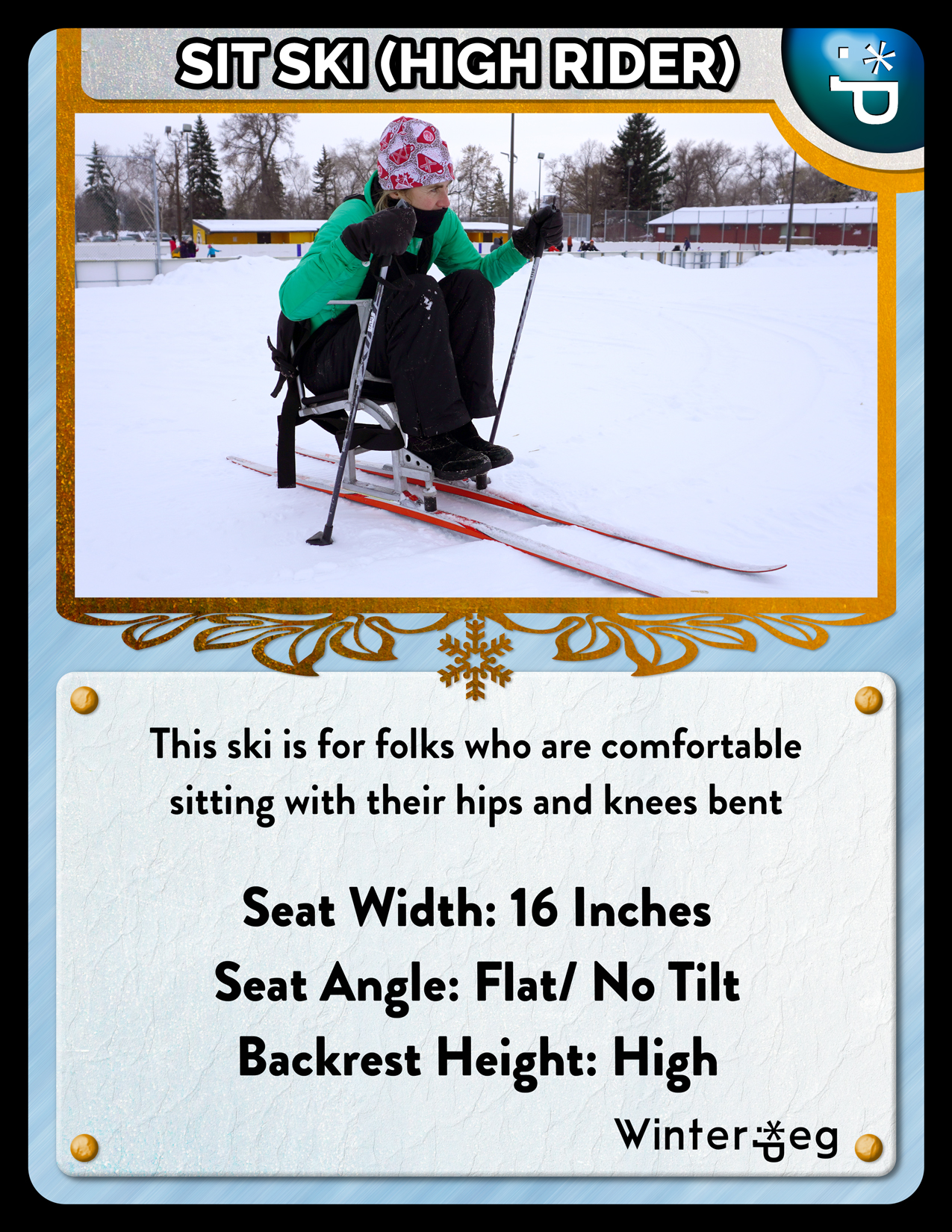
Sit ski #1 – The High-Rider
- This ski is for folks who are comfortable sitting with their hips and knees bent
- This ski helps support the core by bringing your knees close to your chest
- You are further supported by adjustable, wide velcro straps and arm rests on either side
- Recommended for persons with minimal core strength
- Seat width 16 inches
- Seat angle – flat/no tilt
- Backrest height: Medium
Note: The velcro support straps can be applied in a variety of ways. If you come to a library location with an indoor space, we can work together indoors to figure out what feels best for you, before heading out on the ski trail!
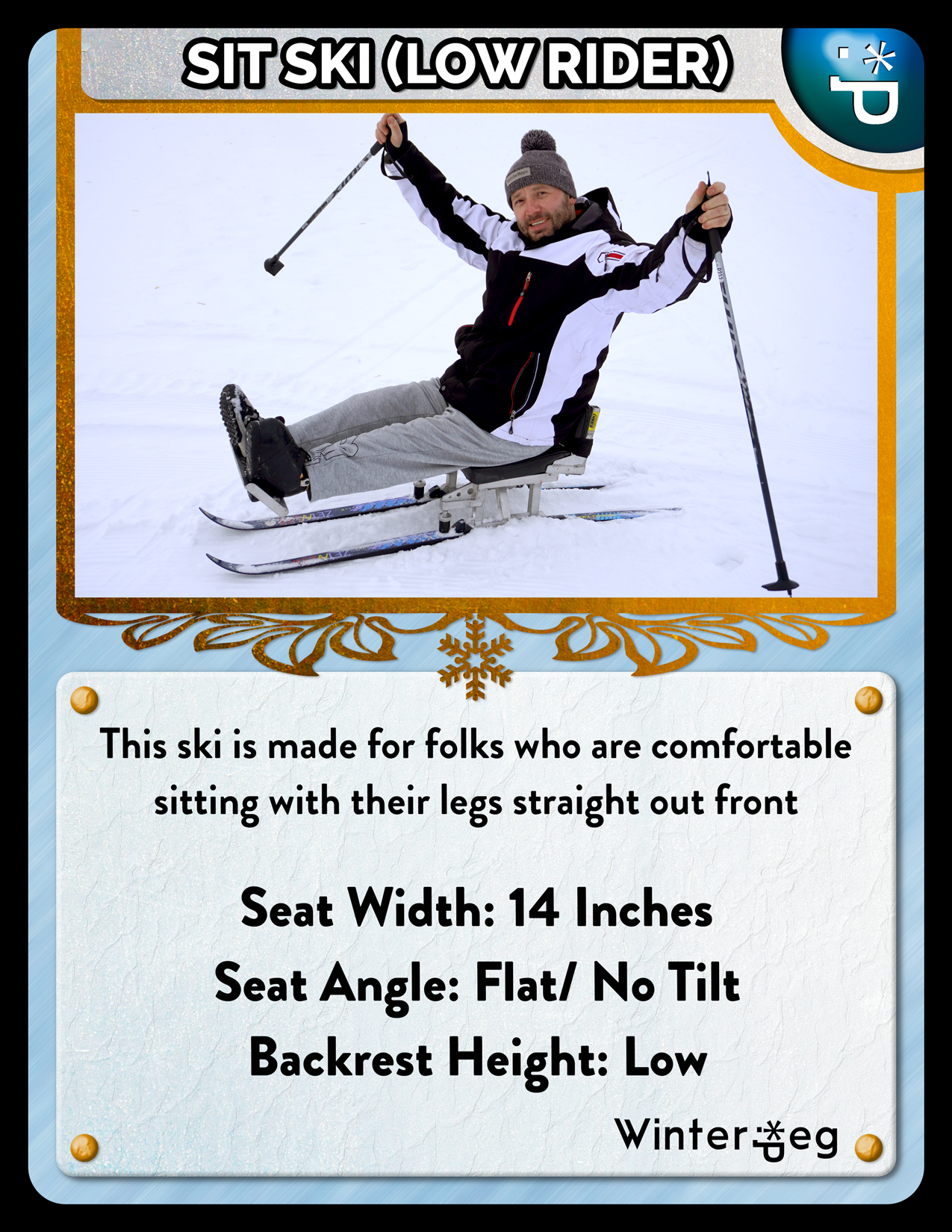
Sit Ski #2 – The Low Rider
- This ski is made for folks who are comfortable sitting with their legs straight out front
- Recommended for persons with some core strength
- There is an adjustable foot rest # inches – # inches
- You are held in place by a wide velcro strap across your waist
- Seat width # inches
- Seat angle – flat/no tilt
- Backrest height: Low
Sit Ski #3 – High Rider with handle
- This ski allows for a second person to provide assistance in navigation and propulsion with a removable handle,
- The assistant can ski behind a participant
- This ski is for folks who are new to skiing and might need help moving forward or making turns along the trail
- This ski is for folks who are comfortable sitting with their legs straight out front
- You are supported with a variety of wide velcro straps across your midsection and over your legs
- Seat width:
- Seat angle: Slight decline
- Backrest height: High
Sit Ski #4 – The Dixon
- This ski is for folks who are comfortable sitting with their hips and knees bent
- This ski helps support the core by bringing your knees close to your chest
- The seat is from a small sledge hockey sled bucket
- Recommended for persons with some core strength
- Seat width measurement
- Seat angle – flat/no tilt
- Backrest height: Medium/low height
Note: This ski was gifted to us from retired Paralympic swimmer, Stephanie Dixon and was designed for someone with narrow hips or smaller stature.

Small Wheel Blades*
- The small wheel blade is a detachable ski that distributes pressure evenly onto the packed snow.
- It can be used with wheelchairs, walkers, strollers or scooters and are designed to stop small, front wheels from stabbing into the snow
- The binding is located at the front of the blade so that the ski can point itself in the direction you wish to travel
- The adjustable clamp lock fits wheel widths from 1.8cm to 6cm

Large Wheel Blades*
- The large wheel blade is a detachable ski that distributes pressure evenly onto the packed snow
- It can be used with wheelchairs, walkers, strollers or scooters and is designed to fit on a larger wheel IMPORTANTLY, on a wheel chair it will only work on the back wheel
- This wheel blade can not be used independently and requires propulsion from a second individual.
- The adjustable clamp lock fits much larger wheel widths
Front wheel blades are meant to give a little more traction over the snow and keep casters from spinning in ruts. They can make using a wheelchair in snow more pleasant.
Back wheel blades will hinder the ability to drive the rear wheel of a wheel chair. However, someone with an assistant can use both front and back Wheel Blades and then be pushed over snowy paths that would otherwise leave them stuck.
Neither will truly work well in deep snow. For that purpose, consider either a sit ski (for those that can propel themselves, a sit ski with a handle (for someone in need of assistance) or an ahkio!
Visually Impaired and Blind Skiing
If you are a blind or vision impaired skier and need a guide for skiing, more indepth information about how to find the library location or trailhead and, for any other supports or information so that you might participate in a mobile ski library, please contact [email protected]
Through the guidance of the Ski for Light initiative, and the Vision Impaired Resource Network, we are working together to create mobile ski libraries where blind and vision impaired participants feel comfortable participating at every location.
Accessibility for vision impaired skiers is a work in progress for the mobile ski library. Here are our goals for the 2022/23 season
- Hi-vis vests available for guides
- Markers at the trailhead, on the turns and at the top and bottom of any major elevation changes.
- Motivated and caring librarians and volunteers who want to help you ski in a way that works best for you
- Train volunteer ski guides
- Ski for Light: Guide Handbook as a resource

